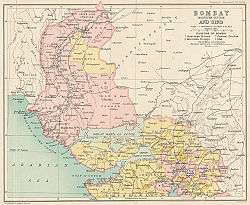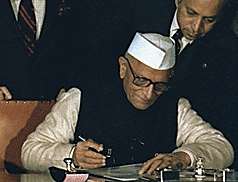Mahagujarat movement
| Mahagujarat movement મહાગુજરાત આંદોલન | |||
|---|---|---|---|
 Rally supporting movement | |||
| Date | 8 August 1956 - 1 May 1960 | ||
| Location | Bombay state, India | ||
| Goals | creation of the separate state of Gujarat for Gujarati-speaking people from the bilingual Bombay state | ||
| Methods | Protest march, Street protest, riot, hunger strike, strike | ||
| Result | formation of Gujarat and Maharashtra states on 1 May 1960 | ||
| Parties to the civil conflict | |||
| |||
| Lead figures | |||
|
| |||
Mahagujarat movement, known as Mahagujarat Andolan locally, was a political movement demanding the creation of the state of Gujarat for Gujarati-speaking people from the bilingual Bombay state of India in 1956. It succeeded in the formation of Gujarat, as well as the Marathi-speaking Maharashtra state, on 1 May 1960.[1]
Etymology
The term Mahagujarat includes all Gujarati speaking area including mainland Gujarat and peninsulas of Saurashtra and Kutch.[2][3]
Writer-politician Kanaiyalal Munshi had coined the term Mahagujarat at the Karachi meet of Gujarati Sahitya Parishad in 1937.[4][5]
Background




During British rule in India, sections of the western coast of India were the part of the Bombay Presidency. In 1937, Bombay Presidency was included as a province of British India.[6][7] After independence of India in 1947, the demand for linguistic states came up. On 17 June 1948, Rajendra Prasad set up the Linguistic Provinces Commission to recommend whether the states should be reorganized or not on linguistic basis. The commission included S. K. Dhar (retired Judge of the Allahabad High Court), J. N. Lal (lawyer) and Panna Lall (retired Indian Civil Service officer), so it was called Dhar commission. In its 10 December 1948 report, the Commission recommended that "the formation of provinces on exclusively or even mainly linguistic considerations is not in the larger interests of the Indian nation".[7][8]
Mahagujarat conference was held in 1948 to include all Gujarati speaking people under one administration which finally resulted in formation of Gujarat.[2][3]
According to the autobiography of Indulal Yagnik, Bombay state chief minister B. G. Kher and the then home minister Morarji Desai visited Dang in May, 1949. B. G. Kher stated that tribal people of Dang spoke Marathi and focus should be on that. Indulal Yagnik and others visited Dang to examine this. Gujarati Sabha also sent a committee for examination and agitate on negligence by government.[1] Committee reported that Dang is more related to Gujarat.[9]
By 1952, the demand for separate Telugu-majority Andhra State had started in Madras State. Potti Sreeramulu, one of the activists demanding Andhra State, died on 16 December 1952 after undertaking a fast-unto-death. Subsequently, Andhra State was formed in 1953. This sparked agitations all over the country demanding linguistic states.[7][10]
In December 1953, Prime Minister Jawaharlal Nehru appointed the States Reorganisation Commission[7] (SRC) to prepare report on the creation of linguistic states. The commission was headed by Justice Fazal Ali so it was called Fazal Ali Commission. The commission reported in 1955 to reorganise states of India.
Agitation

SRC considered to form states on linguistic basis but recommended that Bombay state should stay as a bilingual state. It was further enlarged by the addition of Saurashtra State and Kutch State, the Marathi-speaking districts of Nagpur Division of Madhya Pradesh, and the Marathawada region of Hyderabad. The southernmost districts of Bombay state were included in Mysore State. So it had Gujarati-speaking population in north and Marathi-speaking population in southern parts.[7]
Both Gujarati and Marathi people opposed the SRC’s recommendation and strongly demanded separate linguistic states. The situation became complicated because both of them wanted to include Bombay city (now Mumbai) in their own states due to its economic and cosmopolitan values. Jawaharlal Nehru also suggested to form three states; Maharashtra, Gujarat and centrally governed city-state of Bombay to solve conflict.[7]
Protest broke out in Bombay and other Marathi-speaking districts later known as Samyukta Maharashtra Movement demanding separate Marathi state.[7] Morarji Desai, then the Chief Minister of Bombay State, was against it. On 8 August 1956,[11] some college students of Ahmedabad went to local Congress House near Lal Darwaza to demand separate state. Morarji Desai did not listen them and police repression resulted in death of five to eight students.[6][12] It triggered massive protests across the state. Indulal Yagnik came out of his retirement from politics[6] and founded Mahagujarat Janata Parishad to guide movement. Many protesters including Indulal Yagnik and Dinkar Mehta, Dhanvant Shroff were arrested and kept at Gaekwad Haveli in Ahmedabad for a few days and later imprisoned in Sabarmati Central Jail for three and half months.[13] Protest also spread in other parts of the state which forced Morarji Desai to go on week-long fast. People did not turned up to support him during fast and stayed in home following self-imposed curfew, Janata Curfew. Just before the declaration of carving three states as Nehru suggested, 180 members of Parliament suggested return to bilingual Bombay state together. There was conflict over Mumbai and Dang which was solved through discussions. Gandhian activist Ghelubhai Nayak actively lobbied for accession of Dang in Gujarat.[14][15][16] Mumbai went to Maharashtra and Dang went to Gujarat.[17]
Result
President Rajendra Prasad, Vice-President Sarvapalli Radhakrishnan and Prime Minister Jawaharlal Nehru finally agreed upon the formation of two new lingual states after prolonged agitation. On 1 May 1960, two new states, Gujarat and Maharashtra, were created.[3] Mahagujarat Janata Parishad was dissolved on success of movement.[18] The first government was formed under Jivraj Mehta who become the first Chief Minister of Gujarat.[19]
Monuments

- Shahid Smarak or Khambhi (Martyr Monument) is erected near Lal Darwaja AMTS Bus Stop, Bhadra, Ahmedabad; in memory of college students who went to local Congress House to demand separate state during movement and died in police firing. It has a statue of a young holding torch in hand. So it was called Khambhi Satyagrah (Monument Movement) earlier.[12]
- Statue of Indulal Yagnik was erected in a small garden at east end of Nehru Bridge, Ahmedabad and the garden is named after him.[20]
Participants
Notable individuals who participated in the movement include:
- Indulal Yagnik, the movement's leader[1][18]
- Sanat Mehta[21]
- Satyam Patel
- Dinkar Mehta[6]
- Vidyaben Nilkanth[6]
- Sharda Mehta[6]
- Ashok Bhatt[1]
- Budhdhiben Dhuv[1][11][12]
- Ravishankar Maharaj[1]
- Brahmkumar Bhatt[1]
- Prabodh Raval[1]
- Harihar Khambholja[1][18]
- Dinkar Amin[11][12]
- Ramniklal Maniyar[13]
- Ranjitrai Shastri[13]
- Markand Shastri[13]
Popular culture
Several leaders associated with the movement were writers, poets and even film-makers. Maya, a novel by Indulal Yagnik is set during movement. Jayanti Dalal, Yashwant Shukla, Vinodini Neelkanth, Ishwar Petlikar, Ushnas had also used movement as their inspiration for literary works.[5]
Midnight's Children, a classic by Salman Rushdie, which won the Booker Prize has a backdrop of both the Mahagujarat movement as well as Samyukta Maharashtra movement.[5]
See also
References
- 1 2 3 4 5 6 7 8 9 Desai, Jitendra (4 May 2012). "Revolution in Gujarat's blood". DNA. Retrieved 25 November 2012.
- 1 2 India Guide Gujarat. India Guide Publications, 2007. 2007. p. 25. ISBN 9780978951702. Retrieved 25 November 2012.
- 1 2 3 "Gujarat Govt. Official website". http://www.gujaratindia.com/. Retrieved 25 November 2012. External link in
|work=(help) - ↑ Vashi, Ashish (24 April 2010). "Friendship that formed Gujarat". The Times of India. Retrieved 25 November 2012.
- 1 2 3 Vashi, Ashish (27 April 2010). "Midnight's Children saw golden dawn". The Times of India. Retrieved 25 November 2012.
- 1 2 3 4 5 6 Yagnik, Achyut; Suchitra Sheth (2005). The Shaping of Modern Gujarat: Plurality, Hindutva, and Beyond. Penguin Books India. p. 226. ISBN 9780144000388. Retrieved 24 November 2012.
- 1 2 3 4 5 6 7 Grover, Verinder; Ranjana Arora (1994). Federation of India and States' Reorganisation: Reconstruction and Consolidation. Deep and Deep Publications. p. 392. ISBN 9788171005413. Retrieved 24 November 2012.
- ↑ Virendra Kumar (1976). Committees And Commissions In India Vol. 1 : 1947-54. Concept. pp. 70–71. ISBN 978-81-7022-196-8.
- ↑ TNN (3 January 2012). "Mahagujarat stir sprang out of Dang". The Times of India. Retrieved 25 November 2012.
- ↑ Showick Thorpe Edgar Thorpe (2009). The Pearson General Studies Manual (1 ed.). Pearson Education India. pp. 3.12–3.13. ISBN 978-81-317-2133-9.
- 1 2 3 "Mahagujarat martyrs families felicitated". The Times of India. 2 May 2011. Retrieved 25 November 2012.
- 1 2 3 4 Pathak, Dhwani (2 May 2011). "Unsung heroes". The Times of India. Retrieved 25 November 2012.
- 1 2 3 4 News, Express (2 May 2010). "Youngsters today have no fire in their belly". The Indian Express. Retrieved 25 November 2012.
- ↑ Thomas, Melvyn Reggie (16 January 2015). "Veteran freedom fighter from Dangs, Ghelubhai Naik passes away". The Times of India Mobile Site. Retrieved 18 January 2015.
- ↑ DeshGujarat (16 January 2015). "Father figure of tribal Dang region of Gujarat Ghelubhai Nayak passes away". DeshGujarat. Retrieved 18 January 2015.
- ↑ DeshGujarat (16 January 2015). "How Ghelubhai Nayak and brother Chhotubhai convinced Jawaharlal on Dang's merger with Gujarat". DeshGujarat. Retrieved 18 January 2015.
- ↑ Guha, Ramchandra (13 April 2003). "The battle for Bombay - from book 'Savaging the Civilised andEnvironmentalism: A Global History.'". The Hindu. Retrieved 22 November 2012.
- 1 2 3 Vashi, Ashish (30 April 2010). "Common man who never became CM". The Times of India. Retrieved 25 November 2012.
- ↑ "Next step for Modi -- the national stage". Rediff News. 23 December 2007. Retrieved 25 November 2012.
- ↑ Vashi, Ashish (29 April 2010). "Lifting Indu Chacha to higher pedestal". The Times of India.
- ↑ http://www.dnaindia.com/ahmedabad/1829257/report-maha-gujarat-dreams-have-more-or-less-come-true
Further reading
- Yagnik, Achyut; Suchitra Sheth (2005). The Shaping of Modern Gujarat: Plurality, Hindutva, and Beyond. Penguin Books India. p. 226. ISBN 9780144000388. Retrieved 24 November 2012.
- Grover, Verinder; Ranjana Arora (1994). Federation of India and States' Reorganisation: Reconstruction and Consolidation. Deep and Deep Publications. p. 392. ISBN 9788171005413. Retrieved 24 November 2012.